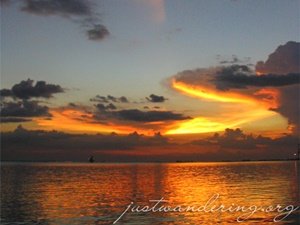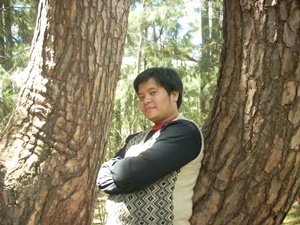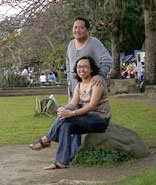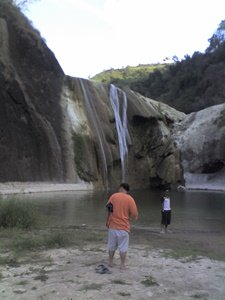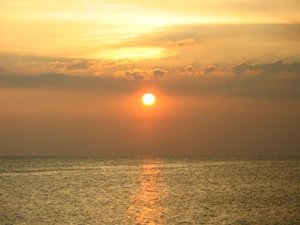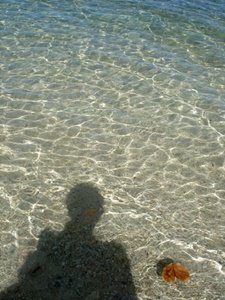Kasarinlan (Nationality): Filipino
Trabaho/Lokasyon (Occupation/Location): IT Personnel/Manila
Paano mo nalaman ang tungkol sa Pilipinas? (How did you find about the Philippines?)
Dugong pinoy. Pinoy blood.
Anong mga lugar sa Pilipinas ang iyong nabisita? (What Philippine locations have you visited?)
Luzon: Candon (Ilocos Sur), San Fernando, San Juan, Bacnotan, Bauang (La Union), Villasis, Urdaneta, Dagupan, Alaminos City, Bolinao, Binmaley, Lingayen, Mangaldan, Sta. Barbara, Mangatarem, San Carlos (Pangasinan), Balanga City, Morong, Orani (Bataan), Balagtas, Bocaue, Malolos, Marilao, Meycauayan, Pulilan, Sta. Maria (Bulacan), Angeles City and San Fernando City (Pampanga), Iba, Pundaquit and San Narciso (Zambales), Alfonso, Cavite City, Tagaytay City, Noveleta, Mendez, Gen. Trias, Dasmariñas, Bacoor, Trece Martires City (Cavite), Los Baños, Calamba City, Calauan, Nagcarlan, Paete, Pagsanjan, San Pablo City (Laguna), Antipolo and Cainta (Rizal), La Trinidad (Benguet), Daet, Naga, Legaspi, Donsol (Bicol Region)
Batangas, Tarlac, Baguio City, and Metro Manila
Puerto Princesa, Palawan
Visayas: Boracay Island (Malay, Aklan), Jordan, Nueva Valencia (Guimaras Island)
Iloilo City
Mindanao: Cagayan de Oro (Misamis Oriental), Iligan (Lanao del Norte), Pagadian City, Guipos (Zamboanga del Sur), Dipolog City, Dapitan City (Zamboanga del Norte)
Camiguin, Bukidnon
Ano ang iyong opinion sa mga sumusunod? (What are your opinions on the following things about the Philippines?)
Mga Lugar (Places)
Mayroong 7,100+ na pulo ang Pilipinas at bawat isa sa mga pulong iyon ay may kanya-kanyang malawak at kamangha-manghang mga bagay na maiaalok. Hindi madaling mapuntahan ang ibang mga lugar ngunit kapagka narating mo ang mga iyon, mabibihag ka ng kanilang ganda, ng marangyang kabuuan at ng mararamdamang kapanatagan. Kailangan lamang matutunan at maituro ang pangangalaga sa bawat kalikasan at huwag hayaang masira ng teknolohiya.There are 7,100+ islands in the Philippines and each one of these islands has its own broad and fascinating array of things to offer. Some places are not easy to get to but once you have arrived, you will be captivated by their beauty, by the lavish fullness and the feeling of peace. We only need to learn and teach the proper care of every environment and not to allow technology to ruin nature.
Pagkain (Food)
Ang Pilipinas ay may iba’t ibang klase ng pagkain. Mula sa western, exotic, asian hanggang sa pinaka-native na putahe. Karamihan sa mga lokal na pagkain ay maaaring hindi maganda ang itsura o amoy para sa mga banyaga ngunit kapagka ito’y natikman, hahanap-hanapin at babalik-balikan. Ang mga prutas na kahit mayroon sa ibang bansa, nangingibabaw ang tamis at kasariwaan nito.The Philippines has different kinds of food. From western, exotic, Asian up to the most native dishes. Most of the local foods may not look or smell good to foreigners but once these have been tasted, one will crave and keep coming back for them. The fruits may exist also in other countries, but they are outstanding in taste and freshness here.
Kultura (Culture)
Napakaraming kultura ng Pilipinas. Mula sa iba’t-ibang rehiyon ay may kanya-kanyang pagpapahalaga sa kanilang nakagisnang kultura. Mula sa pamumuhay, sining, musika, paniniwala, relihiyon, at marami pang iba. Malawak ngunit maipagmamalaki ang kulturang atin. Sana lamang ay bigyang pansin ng bawat isa ang mahahalagang aspeto nito at pahalagahan.The Philippines has many cultures. From different regions people have different ways of valuing the cultures they grew up with. From livelihood, art, music, beliefs, religion, and many others. Our own culture is vast but worthy of pride. I only wish that every one of us could pay attention and give importance to the important aspects of this.
Mga Tao (People)
Pilipino… kadalasa’y Pinoy o Noypi kung tawagin. Mula sa opinyon ng mga banyaga – masipag, matiyaga, maabilidad, palangiti kahit sa gitna ng hirap at kalamidad at higit sa lahat, palakaibigan at maasikaso. Mula sa opinyon ng mga kapwa ko noypi — mabuting kaibigan, masipag, matiyaga, maasikaso, magaling makisama at may mga nagsasabing walang disiplina, mandaraya, gaya-gaya at mahilig sa imported.Ngunit may isang bagay na maaaring hindi alam ng nakararami tungkol sa mga Pilipino. Kung bakit sa gitna ng kahirapan, makikita ang mga ngiti at sa bawat sakuna o kalamidad, nakukuha pang tumawa at magbiro. “Pamilya ang nakakapagpasaya sa mga pinoy, hindi pera o karangyaan”.
The Filipino… often called Pinoy or Noypi. From the opinion of foreigners – industrious, patient, resourceful, smiling even in the midst of poverty and calamity and most of all, friendly and caring. From the opinion of my fellow Noypi – a good friend, industrious, patient, caring, good with people and there are those who say undisciplined, dishonest, parroting and overfond of imported goods.
But there is one thing that many may not know about the Filipino. This is that in the midst of poverty, you may still see him smiling and that in every disaster or calamity, he still manages to laugh and crack jokes. “Family is what makes Pinoys happy, not money or luxury.”
Ano ang ayaw mo sa Pilipinas? (What do you dislike about the Philippines?)
Nakapagtatakang mga banyaga pa ang may magandang panananaw sa atin. Siguro dahil sa alam natin ang sakit ng bawat isa. Para sa akin, ipinagmamalaki ko ang pagiging pinoy, hindi dahil isa ako sa kanila. Totoo man lahat ang mga nababanggit sa itaas, masama man ito o mabuti. Hindi ko itatanggi alinman doon sapagkat may mga panahong may katotohanan iyon. Ilan sa mga halimbawa o karagdagan dito ay mañana habit (mamaya na), crab mentality, Filipino time at pananamantala sa mga lokal at mga banyagang biyahero na kung ating susuriin, dala ng kawalang disiplina at kahirapan.At ang nangungunang problema ng bayan… korapsiyon. Mula sa pinakamababang antas ng lipunan hanggang sa pinakamataas na namumuno. Ngunit hindi dapat isisi lamang ang mga ito sa gobyerno sapagkat ang bumubuo ng gobyernong ito ay mga Pilipino din. Bumabagal ang pag-unlad at pumapangit ang imahe. Hindi ito dapat gawing dahilan upang hindi maisaayos ang mga ito. Maraming bansa ang may ganito ring mga kaugalian ngunit bakit sila umaangat at ang mga pinoy lamang ang nangingibabaw sa mga pangit na paningin? Siguro’y dahil wala tayong ginagawa upang maitama ang mga ito. Walang kumikilos para panatilihin ang kanilinisan at kaunlaran ng bawat rehiyon at walang pakialam sa naidudulot na masamang epekto sa napakaraming likas na yaman na kung titingnan, kayang sustenahin ang mga pangangailangan ng Pilipinas. Siguro’y dahil sa Pilipino mismo ang nagpapabagsak sa kapwa niya Pilipino. Ilan lamang ito.
Sana’y mabigyang-pansin ang mga opinyon at suhestiyon ng mga nagbigay nang kanilang Photographic Profile upang mapansin ng mga kinauukulan at maiangat ang antas ng bansang Pilipinas. Layunin ng website na ito na maiangat ang turismo ng bansa at maipagmalaki ang likas na yaman.
It is puzzling that foreigners are the ones who have a good view of us. Maybe it’s because we know each other’s problems too well. As for myself, I am proud to be Pinoy, not because I am one of them. Though all of the things stated above are true, bad or good. I will never deny any of them because there are times when there is a truth to them. A few examples or additional info are the mañana habit (do it later), crab mentality, “Filipino time” and taking advantage of local and foreign travelers which, if we will examine them, are due to lack of discipline and poverty.
And the country’s leading problem… corruption. From the lowest level of society to the highest position in office. But the government is not the only one to blame for all this because the Filipinos are also the ones who make up this gvoernment. Progress is slowed and the national image is tarnished. This should not be turned into a reason for not fixing these things. Many countries have these habits also but why are they progressing and the Pinoys only are excelling in bad imagery? Perhaps it’s because we’re not doing anything to fix these. No one is moving to maintain cleanliness and progress of each region and there is no regard for the bad effects brought onto the many natural treasures which, if examined closely, may sustain the needs of the Philippines. Maybe it’s because the Filipino himself causes the downfall of his fellow Filipino. These are just a few.
I hope the opinions and suggestions of the people who gave their Photographic Profiles are given attention, so that the authorities may take notice and raise the quality of life in the nation of the Philippines. This website aims to promote tourism in the country and boast of its natural treasures.
Ano ang gusto mo sa Pilipinas? (What do you like about the Philippines?)
Halos lahat. Ang mga pagkain, mula sa simpleng pritong isda na may talbos ng kamote hanggang sa adobong tagalog, mga kilawin, bopis, maasim na sinigang at ang nakapaglalaway na mga lamang-dagat. Ang kultura, mula Aparri hanggang Jolo. Ang mga tao, na laging nakangiti anuman ang dumaan na mga sakuna at problema. Ang klima, tag-araw, tag-ulan at taglamig. At ang mga lugar, mula sa kailaliman ng dagat hanggang sa nagtataasang bundok. Mula sa malawak na kabukiran hanggang sa pinakasulok ng mga kuweba. Mula sa makulay na pagsikat ng araw hanggang sa iba’t-ibang anyo at ganda ng paglubog nito.At higit sa lahat, ang lambanog at mga lokal at natural na alak gawa sa buko, bigas, tubo, kape at iba pa. At ang isa sa pinakamasarap na beer, San Miguel Beer. Ito ang Pilipinas.
Nearly everything. The foods, from simple fried fish with yam sprouts to Tagalog adobo, kilawin dishes, bopis, sour sinigang and the mouth-watering seafoods. The culture, from Aparri to Jolo. The people, who are always smiling no matter what misfortunes and problems befall them. The climate, sunny, rainy and cold. And the places, from the lowest point of the ocean to the peaks of the mountains. From the vast fields to the very corners of caves. From the colorful sunrises to the different forms and graces of its setting.
Above all, the lambanog (coconut vodka) and local and natural wines made of coconut, rice, sugar cane, coffee and a lot more. And one of the best beer, San Miguel Beer. This is the Philippines.
Ang paborito mong mga lugar sa Pilipinas. (Your favorite place/s in the Philippines.)



